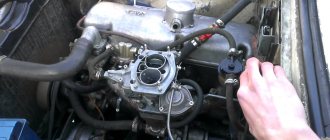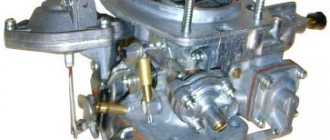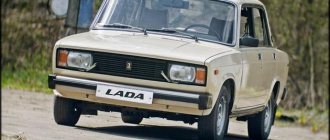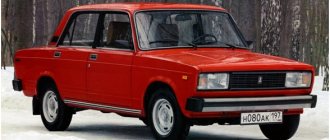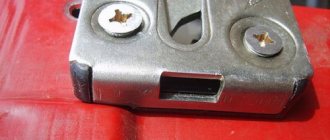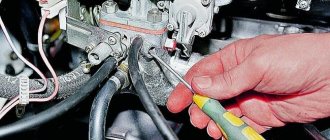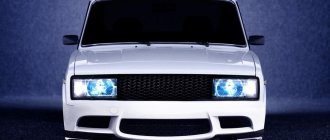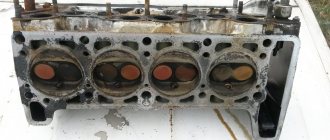VAZ-2105
On the instrument panel there is the minimum required for the early eighties.
The first “fives” had anti-reflective instrument glasses, which were eventually replaced with regular ones to reduce the cost. On the instrument panel there is the minimum required for the early eighties. The first “fives” had anti-reflective instrument glasses, which were eventually replaced with regular ones to reduce the cost.
VAZ-2105
In comparison with previous Zhiguli models, the panel of the “five” looked modern.
Cars from the early years can be identified by the glove compartment lock located on the left side of the lid. Later he moved to the center. In comparison with previous Zhiguli models, the panel of the “five” looked modern. Cars from the early years can be identified by the glove compartment lock located on the left side of the lid. Later he moved to the center.
Test
Past and present advantages
In Soviet times, this model of the Volzhsky Automobile Plant was considered quite attractive from a design point of view and could even compete with its European counterparts.
Attention is drawn to the rectangular lighting optics, bumpers made of aluminum and with plastic lining, as well as neat mirrors mounted on the doors.
In terms of geometric cross-country ability, the Five can compete with modern crossovers. You can move confidently on light off-road conditions thanks to short body overhangs and impressive ground clearance of 180 millimeters.
Minimum Required
The front panel is unremarkable. The instrument panel is laid out correctly. It is perfectly readable due to clear digitization, but it does not have a tachometer, which is why the engine speed has to be determined by ear.
There is an air conditioning system on the dashboard, which is regulated by three sliders - it looks extremely archaic, but there are no complaints about ease of use. There is a slot on the center console for mounting a 1DIN radio.
VAZ-2105
A decent part of the luggage compartment is occupied by a spare wheel and a fuel tank.
Along with the car, the owner received a lot of interesting antiques, including cigarette cords with a fabric braid. A decent part of the luggage compartment is occupied by a spare wheel and a fuel tank. Along with the car, the owner received a lot of interesting antiques, including cigarette cords with a fabric braid.
Carburetor
Carburetors 05 and 07 were specially designed to replace the imported Weber used in the first batches of VAZ-2101 and 2103. The created device was called “Ozone”, and it was given catalog numbers 2105-1107010 and 2107-1107010. A total of 4 modifications were created, indicated by a pair of additional numbers in the part number. For example, "Ozone 2105-1107010-20".
There are 5 signs that allow you to determine how VAZ-2105 carburetors differ from 2107 different Ozone models:
- Cross-section of air and fuel jets.
- Diameter of diffusers.
- Availability of a forced idle economizer (EFI).
- Automatic air damper (choke) drive.
- The presence of a fitting for the vacuum corrector of the ignition distributor.
With the appearance of the VAZ-2108 car on the assembly line, the Ozone carburetor was supplanted by a more advanced design - Solex. She was assigned the following catalog numbers:
- 21053-1107010-20;
- 21073-1107010.
The innovation was a 2-part design (instead of 3), a simple EPHH system (screw-sensor, EM valve, control unit) and the presence of a fitting for returning excess fuel to the tank (“return”). The latter allows you to start the engine if the metering needle is faulty, the floats are incorrectly adjusted and eliminates the formation of air locks between the carburetor and the fuel pump. The latter led to the engine stopping due to lack of fuel.
VAZ-2105
Thanks to the transparent cover of the block, you can judge the condition of the fuses without removing it.
This is in theory. Over time, the plastic becomes cloudy, and it is no longer possible to see anything. Thanks to the transparent cover of the block, you can judge the status of the fuses without removing it. This is in theory. Over time, the plastic becomes cloudy, and it is no longer possible to see anything.
Chassis
With all the skepticism towards the heritage of the Soviet automobile industry, it must be said that VAZ cars of the eighties, in terms of transmission, did not differ too much (for the worse) from the average modern car. But in the nineties the picture began to change. If previously a 4-speed gearbox often outlived the car as a whole, now it may need to be rebuilt after a mileage of 50,000 km.
The same applies to the chassis. If during the era of socialist realism the replacement of silent blocks, which ensured a consistently safe and comfortable ride, would have been required only after 60–80 thousand km, now the knocking noise can appear even after 40 thousand. However, now replacing them in any garage-type service costs mere kopecks, and then this part still had to be obtained. Previously, the worm steering mechanism, as a rule, began to play after 100 thousand km. Nowadays one can only dream of such a figure.
On the other hand, maybe it’s for the better - often only a weightlifter can actively “oil” the steering wheel on a new car. But as for shock absorbers, neither in those days, nor much later, they were particularly durable. But there is also a reverse trend. If previously the service life of ball joints in the front suspension and tie rod ends was several times less than any foreign analogues, today their service life can be considered more or less acceptable.
VAZ-2105
The “fives” of the first years of production (like the VAZ-2104 and 2107) had their own 13-inch stamped wheels with an original design.
Later they were replaced by wheels unified with the VAZ-2106. The “fives” of the first years of production (like the VAZ-2104 and 2107) had their own 13-inch stamped wheels with an original design. Later they were replaced by wheels unified with the VAZ-2106.
Exterior
Both models feature the angular, brick-like design typical of the early eighties. For this, model 2105, and then 2107, received their popular nickname - “tomato box”. The key differences in the exterior of these cars are:
1. Hood.
In the seventh model it is smooth, with a stamping in the center, which goes into the radiator grille.
The fifth one has 2 rectangular indentations on it that go from the headlights to the windshield.
2. Radiator grille.
This detail is the first to catch your eye, and only thanks to it many car enthusiasts know how the VAZ-2107 differs from the 2105.
The latter was fitted with a rectangular grille made of black plastic. In the seventh model, edging was added to it. Both parts were often coated with chrome, but examples can also be found without it. For this detail, the “seven” received the nickname “Russian Mercedes”.
3. Front and rear bumpers.
The bumpers used in the VAZ-2105 were all-aluminum with a black plastic belt. In 2107, metal was abandoned in favor of plastic, but the appearance of a metal base was retained. This was done using a chrome insert in the upper half of the part. Since 2008, bumpers from the seventh model have been installed on 2105 and 2104.
4. Trunk lid.
In the Lada-2105 it has 2 depressions, repeating the pattern on the hood.
In 2107 the lid is smooth. A gray plastic plate is attached to the edge of the trunk on the right side. It indicates the model name and the size of the installed engine. For example, “Zhiguli 1200/1300/1500L” or “Zhiguli” / Lada 2107.
In the last years of production (2008-2012), the trunk lid from the VAZ-2105 was installed on both models. This decision was made to achieve greater unification and reduce production costs.
5. Rear lights.
This is the last body detail by which you can determine how the VAZ-2105 differs from the VAZ-2107. The differences in the rear lights are minimal - in the “seven” the size of the reversing light (moon-colored) is doubled and the size of the brake light is reduced by the same amount.
VAZ-2105
The front panel of a pre-production car from 1978.
By the time it was launched on the assembly line, essentially only the color had changed. The front panel of a pre-production car from 1978. By the time it was launched on the assembly line, essentially only the color had changed.
| Model | VAZ | ||||||
| 2105 | 21051 | 21053 | 21053i | 21054 | 21055 | 21059 | |
| COMMON DATA | |||||||
| Dimensions, mm: length / width / height / base | 4130 / 1620 / 1446 / 2424 | ||||||
| Track front/rear | 1365/1321 | ||||||
| Trunk volume, l | 345 | ||||||
| Curb / gross weight, kg | 995 / 1395 | 995 / 1395 | 995 / 1395 | 995 / 1395 | 1060 / 1460 | 995 / 1395 | 995 / 1395 |
| Acceleration time 0–100 km/h, s | 18 | 20 | 17 | 17 | 16 | 23 | 9 |
| Maximum speed, km/h | 145 | 142 | 148 | 148 | 150 | 125 | 180 |
| Fuel / fuel reserve, l | AI-92/39 | AI-92/39 | AI-92/39 | AI-92/39 | AI-92/39 | DT/39 | AI-92/39 |
| Fuel consumption city / suburban / mixed | 10,1 / 7,5 / 10 | 10,1 / 7,5 / 10 | 9,6 / 6,9 / 9,2 | 9,5 / 6,9 / 9,2 | 9,6 / 6,9 / 9,2 | 8,0 / 5,8 / 6,7 | 12,5 / 9,5 / 11 |
| ENGINE | |||||||
| Type | petrol | diesel | petrol | ||||
| Location | front longitudinal | ||||||
| Configuration / number of valves | P4/8 | P2/4 | |||||
| Working volume | 1290 | 1198 | 1452 | 1451 | 1568 | 1524 | 1654 |
| Power, hp at rpm | 64 / 5600 | 59 / 6500 | 71 / 5600 | 67 / 5600 | 74 / 5600 | 50 / 4600 | 140 / 6400 |
| Torque, N*m at rpm | 92 / 3400 | 85 / 3400 | 104 / 3400 | 103 / 3400 | 120 / 3000 | 92 / 2500 | 186 / 4500 |
| TRANSMISSION | |||||||
| Type | Rear wheel drive | ||||||
| Transmission | M4 | M4 | M4 | M5 | M4 | M4 | M5 |
| CHASSIS | |||||||
| Suspension: front/rear | spring independent lever/spring dependent | ||||||
| Steering | worm without amplifier | ||||||
| Brakes front/rear | disc / drum | ||||||
| Tire size | 175/70 R13 | ||||||
VAZ-2105: attempt number five
Engine
This is an important part of any car. But due to the peculiarities of AvtoVAZ’s production policy, this is not a detail by which one can understand how the VAZ-2105 differs from the VAZ-2107.
On the VAZ-2105, in addition to engines 2101 and 2103, a model with the index 2105 was installed. It was created by making several changes to the design of 21011:
- Timing belt drive instead of chain drive.
- Cast aluminum cylinder head cover.
- Recesses for valves to prevent damage if the belt breaks.
These measures have led to a significant reduction in noise from engine operation and an increase in service life.
The VAZ-2107 was equipped with the following engines: 2103, 2105 and 2106 with a volume of 1500, 1300 and 1600 cm3, respectively. There were also modifications for the needs of the traffic police, the Ministry of Internal Affairs and the KGB. They used a VAZ-4132 rotary piston engine with a volume of 1.6 liters and a power of 140 hp. With.

